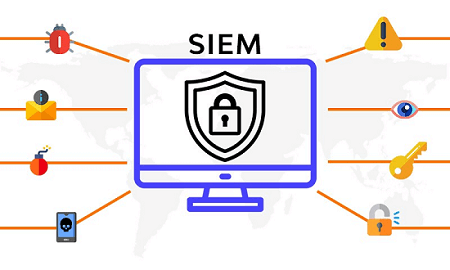How Does SIEM Work

A Security Information and Event Management (SIEM) system works by collecting, aggregating, analyzing, and correlating log data from various sources within an organization's IT environment. The goal is to provide a centralized platform for monitoring security events in real-time, detecting anomalies or potential threats, and facilitating incident response. Here is an overview of how SIEM works:
-
Data Collection:
- SIEM systems collect log data from diverse sources, including servers, network devices, security appliances, applications, and endpoints. This data contains information about events, activities, and changes occurring throughout the IT infrastructure.
-
Log Normalization:
- The collected logs are normalized to a common format. Normalization involves standardizing log entries, ensuring that data from different sources adhere to a consistent structure. This step is crucial for accurate correlation and analysis.
-
Data Aggregation:
- The SIEM aggregates log data from multiple sources into a centralized repository. This repository, often referred to as a log repository or data lake, serves as a centralized store for all security-related data.
-
Real-Time Analysis:
- A correlation engine within the SIEM system analyzes log data in real-time. The correlation engine identifies patterns, relationships, and sequences of events that may indicate potential security incidents. This analysis helps in detecting threats that may not be apparent when examining individual events.
-
Correlation of Events:
- The SIEM correlates events by comparing information from different sources and identifying relationships between seemingly unrelated activities. For example, the system might correlate multiple failed login attempts with an increase in network traffic to detect a potential brute-force attack.
-
Alert Generation:
- When the correlation engine identifies an event or sequence of events that could indicate a security incident, the SIEM system generates alerts. These alerts are sent to security analysts or administrators, notifying them of the potential threat.
-
Incident Investigation:
- Security analysts use the SIEM interface to investigate alerts and security incidents. The SIEM provides detailed information about the timeline of events, affected systems, and contextual data to aid in the investigation process.
-
Dashboard and Reporting:
- SIEM systems offer dashboards and reporting features that provide a visual representation of security data. Dashboards typically include charts, graphs, and tables, enabling security professionals to quickly assess the organization's security posture.
-
User and Entity Behavior Analytics (UEBA):
- Some SIEM systems incorporate UEBA capabilities to monitor and analyze user behavior and entity activities. This helps in detecting abnormal patterns or deviations from established baselines that could indicate insider threats or compromised accounts.
-
Integration with Security Tools:
- SIEM systems integrate with other security tools, such as antivirus solutions, firewalls, and intrusion detection/prevention systems. This integration allows for a coordinated response to security incidents and enhances the overall effectiveness of the security infrastructure.
-
Incident Response and Remediation:
- SIEM tools facilitate incident response by providing information needed to contain, mitigate, and remediate security incidents. Security teams can use the SIEM to take corrective actions and implement security measures to prevent similar incidents in the future.
-
Compliance Management:
- SIEM solutions assist organizations in meeting regulatory compliance requirements by providing features for log management, audit trails, and reporting. Compliance reports can be generated to demonstrate adherence to specific regulations.
By centralizing and correlating security-related data, SIEM systems help organizations gain visibility into their IT environments, detect and respond to security incidents, and improve overall cybersecurity posture. The continuous monitoring and analysis provided by SIEM contribute to a proactive approach to cybersecurity.
Thank you.
